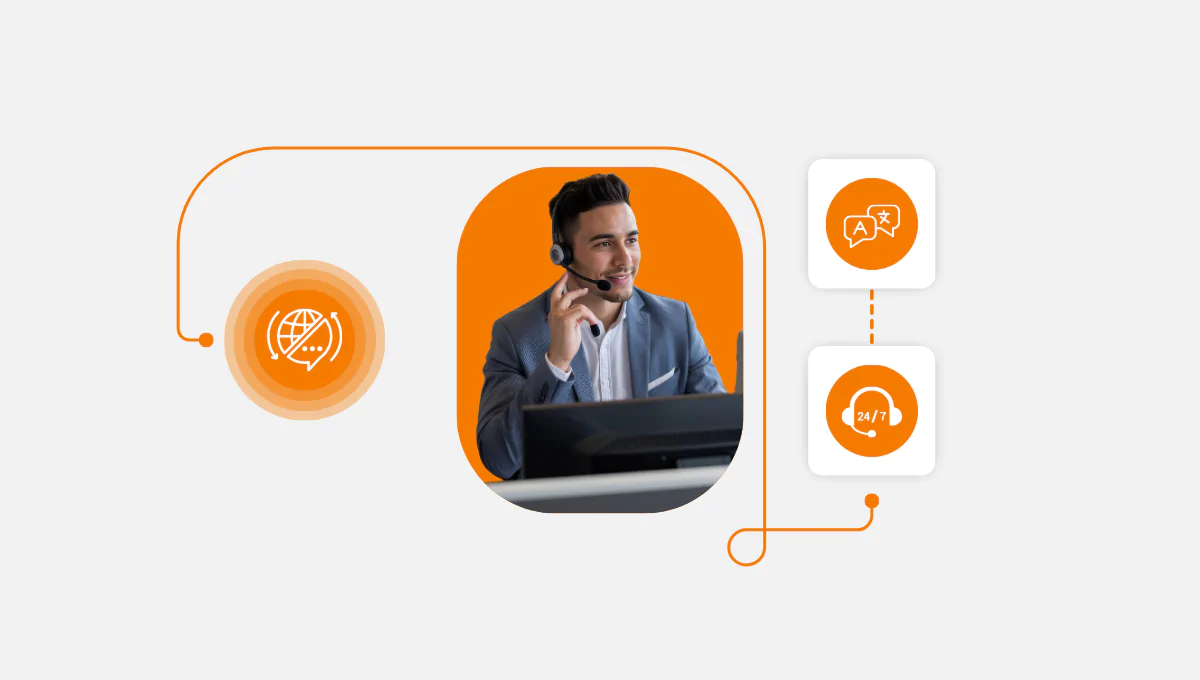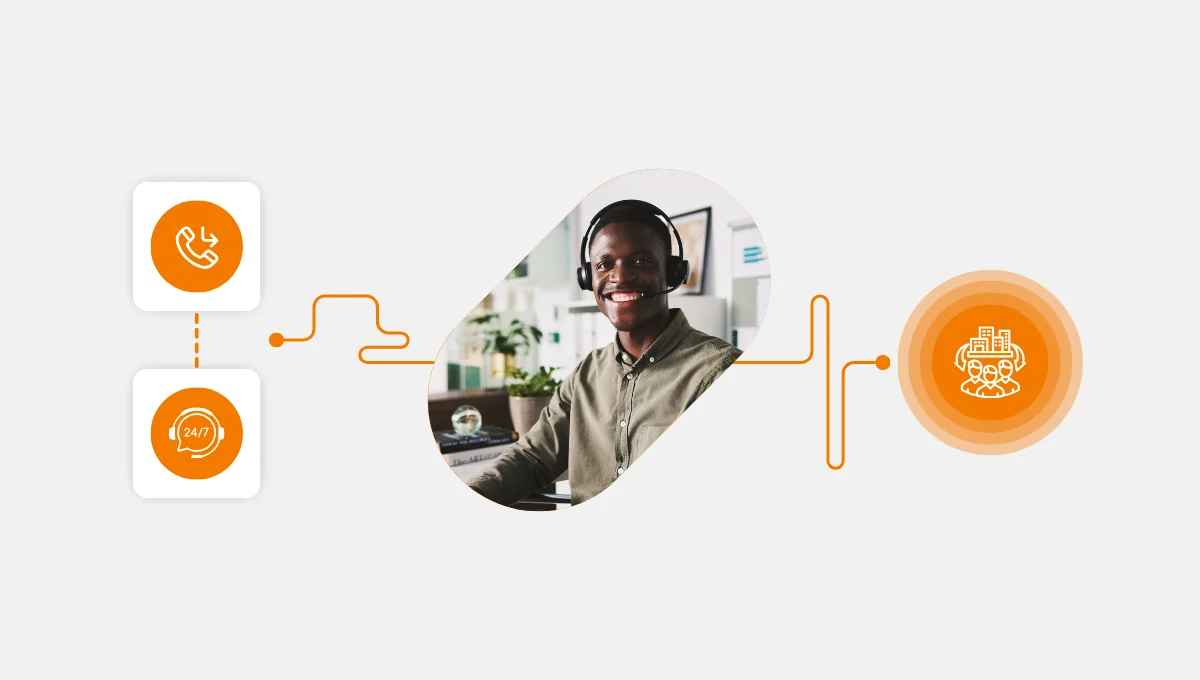The largest global population is English speakers, at 1,456 million. This is followed by Mandarin, at 1,138 million, then Hindi, Spanish, French, and modern-standard Arabic. So if you are setting up a multilingual call center, these languages should form the basis. But it’s not limited to this; suppose you are targeting a certain demographic.
A multilingual call center solution is not really supported by the traditional form. This form dictates that all agents are housed in one location. For global reach, this is impractical. You need to support remote working.
Fortunately, Call Center Studio’s cloud call center software holds space for such advancements. How? You are about to find out. But a sneak peek is that this approach solves geographical, temporal, and dialectical problems. It basically makes your contact center an all-rounded 24/7 solution hub.
Here, you’ll learn how to build a multilingual call center. You’ll start by understanding why it’s important and then how to create one.
Ready to learn?
Here is our take.
Why is Multilingual Support Important for Modern Call Centers?
A mixed global customer base requires an expansion of your call center’s linguistics. This section highlights the essentiality of having a multilingual call center solutions call center. Some important aspects such as a center onboard is that it helps you:
Ramp Up Customer Satisfaction Rates
The priority is bolstering customer loyalty and satisfaction rates. According to an Intercom survey, about 70% of clients remain loyal to a company offering services in their native languages.
Reach Untapped Markets
Once your call center starts offering multilingual call center solutions, you welcome new clients. For instance, if you onboard native French or Swahili agents, you attract clients using that dialect.
These previously untapped markets become attainable. With a few marketing efforts, you can tap into and build a relationship with this new market.
Surpass Competitors
You stand out from competitors once you become a multilingual call center solutions company. By simply offering services in a client’s native language, you become the preferred brand.

How Can a Call Center Become Multilingual?
Now, how do you create a multilingual support center? It might seem like a huge leap, but reading this section will help. We will cover three ways to build a successful system. They are;
Start with a Language Assessment
The first thing to do is analyze your customer base demographics. While you do this, also consider your future expansion zones. After narrowing down these zones, pinpoint the most spoken languages.
Reviewing what your competitors offer is also a great place to start.
Get the Best Team for the Job
Once you know which languages to onboard, start recruiting native speakers in those dialects. The best way to do this is to hire remote workers worldwide. Currently, about one in five employees are remote workers.
So, hiring a remote multilingual staff is nothing out of the ordinary, it’s already being done.
Technology is Your Best Bet
Technological solutions act as the glue for newly acquired remote staff. It helps you with multilingual IVR systems as well as translation tools.
Technology also helps with language routing capabilities. When a customer calls, they are directed to the agent speaking their language.
Tech helps you install translation features on your knowledge bases, too. For example, a technical manual that switches to multiple dialects besides English. Another technology feat is software that offers accurate monitoring and analytics.

What are the Challenges of Running a Multilingual Call Center?
Even though the benefits of multilingual customer support win, they also come with challenges. Some to anticipate are the likes of:
Quality Consistency
Language modification is treading in foreign spaces—literally. And so, expect quality issues like language proficiency, cultural sensitivity, and interpreter availability. The across-the-board solution may be to use a standardized script. Here, both an English and a Spanish-speaking agent share the same message.
Next, set up dialect-specific quality metrics and have a monitoring system. Implementing feedback systems for each group also helps. You can formulate the feedback channels as after-call customer satisfaction surveys.
Cultural Nuances
Every culture has its own rules, expectations, and taboos. So, is your new staff sensitized to these?
Even if they are, running in-house cultural sensitivity training is a must. Also, following region-specific communication guidelines helps. This may include how your agents address specific clients by title and respectful names.
Cultural sensitivity will also mean your agents understand the local holidays and customs. Things like greetings are highly applicable here.
Resource Acquisition and Management
Finding a multilingual staff is easy; managing it might be the issue. Here, the main problem is usually language barriers. The solution is to get translators on board as well as make the new hires.
Translators bridge the gap and help you manage the new team.
The next issue under resource acquisition is finding the right tech partner to help. The cloud call center software provider must also be multilingual; otherwise, there will be a clash. Luckily, Call Center Studio is multilingual and a great place to start.
Time zone differences could also hinder the transition. The remedy? Run the operation on an omnichannel hub.
Best Practices for Success
By now, you already have a plan. However, to excel in multilingual customer support, there is more to it than implementation. The bulk of it is usually in doing the following:
- Focusing on quality by regularly running agent assessments.
- Offering ongoing training and development.
- Monitoring all language service delivery.
- Implementing the right technology—AI, omnichannel support, and speech analytics.
- Utilizing customer feedback analytics for continuous refinement.
Conclusion
The bottom line of building a multilingual call center is finding the right combination of a few things. That’s the right staff and the best technology. However, this is a glimpse of what’s possible. You also require efficient management of this system.
Thankfully, now you have the know-how, plus more. Call Center Studio’s advanced cloud call center software can create a robust multilingual support system. This system meets your customers’ needs across dialects and cultures.
Ready to take your customer service global? Contact us to learn how our resolutions can help you build a world-class multilingual call center.




